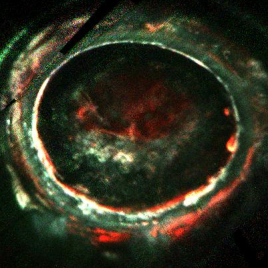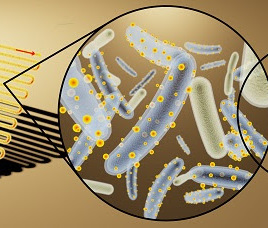An overview of 1.6 million deaths in Ontario over a 20-year period revealed that people with schizophrenia are three times more likely to die—and die younger—than the general population. New research revealed that the most vulnerable schizophrenia patients are female, younger and living in lower-income neighbourhoods. While the average life expectancy for people with schizophrenia […]
Category: Paper of Interest
First-ever genome-editing study on human embryos sheds light on early human development
New research describes how CRISPR-Cas9 genome editing technique has been used to study the role of the OCT4 gene, thought to be required for pluripotency and reprogramming in human cells, in human embryos. The molecular mechanism of this early developmental period is poorly understood, so a successful technique to study this represents proof of concept […]

Pre-Cambrian Explosion trace fossils offer a new window into Earth’s oldest lifeforms 
According to the fossil records, nearly all animal phyla appeared within a relatively short timespan, dubbed the Cambrian Explosion due to its brevity and significance. But a recent study is contributing to another narrative, one that suggests the “explosion” wasn’t as sudden as scientists first thought, and that favourable circumstances had been lining up since the preceding […]
Attacking cancer cells by cutting off their sugar supply 
Cancer cells, unlike healthy ones, use a fermentation process to break down sugar to create energy. This metabolic process is much less efficient and uses a lot more sugar than the oxygen conversion of healthy cells, and it’s known to cancer researchers as the Warburg effect. A recent study describes the mechanism behind this effect, and […]
Paper-based test for tuberculosis a potential low-cost solution for developing countries
Researchers have developed a fast, cost-efficient tuberculosis test that can be read using a smartphone. The team combined gold nanoparticles with fluorescent single-stranded DNA sequences that bind to the genetic material of TB-causing bacteria, Mycobacterium tuberculosis. These nanoparticles were then incorporated into a paper-based device. If the smallest amount of M. tuberculosis is detected on the device, the […]
The dynamics of food webs 
New research proposes a model to explain how simple food webs are formed within a community. A food web links each species with its predators and prey, but it’s not clear how any particular association emerges from a wide range of possible webs. In the present study, researchers describe a principle of mutual replenishment, which […]
A gene that makes ants better plant bodyguards 
Amazonian ants Allomerus octoarticulatus act as bodyguards, defending the Cordia nodosa plant against herbivores—such as grasshoppers—in a mutualistic relationship. A recent study pinpoints a genetic variation among A. octoarticulatus that makes some of the ants better bodyguards: a certain foraging gene makes the ants better at discovering the grasshoppers attempting to feed on the plant. Researchers studied two ant colonies, one of which […]

Understanding the role of phosphorus in Canadian freshwater algal bloom 
Numerous bodies of water in Canada are affected by algal bloom, which occurs when the water is saturated with excess nutrients. New research examines the process through which one such nutrient, phosphorus, is recycled between mud on the lake bottom and water surface. Study authors reviewed data from 70 water bodies in Canada, including Lake Simcoe, […]

Evidence of first vertebrate with polarized vision 
Most invertebrates can detect polarization of light in addition to color and intensity, which helps with target detection, orientation and communication. But a recent study found evidence of the first vertebrate that possesses polarization vision: the northern anchovy. Optic nerve recordings from anchovies have shown that the fish’s eyes show retinal segregation for independent colour […]
Presence of certain bacteria in children’s throat linked to bone and joint infection 
New research suggests a new method for identifying children at risk for bone and joint infection by looking for the Kingella kingae bacteria in their throats. Study authors examined 65 children admitted to hospitals in Canada and Switzerland with joint or bone infection, and found that 70% of them also carried the bacteria in their […]
Babies learn to detect fearful faces as early as 3.5 months of age 
An infant can tell a fearful expression from a happy one as early as three months after being born, results of a new study suggest. Fear detection is an important evolutionary mechanism and is thus developed at a young age, but present research is the first to show a precursor to this important ability. To […]

The mechanism behind Jupiter’s colorful auroras is different from Earth’s
Auroral emissions—also known as Northern or Southern Lights on Earth—are very powerful on Jupiter, which is why scientists thought the process behind auroras on the biggest Solar System planet was similar to the one responsible for Earth’s brightest auroras. But recent research suggests this is not the case. On our planet, two processes are responsible […]

How a deadly virus spreads among young farmed fish in the Pacific Northwest
A new study explores the spread of infectious hematopoietic necrosis virus (IHNV), which plagues Pacific salmon and trout. Researchers looked at the spread of IHNV among juvenile hatchery-raised fish in the Pacific Northwest, where rates of infection and mortality are high. Hatchery-raised salmon present a unique challenge when it comes to IHNV detection, because while hatcheries […]
Brains of athletes in contact sports differ from those in non-contact sports 
Athletes participating in collision and contact sports have differences in brain structure, and function compared to athletes in non-contact sports, recent research suggests. Unlike previous research, which explored the effects of collision sports like hockey and football, the present study focused on sports where body contact is ‘permitted, but not purposeful” – such as soccer, […]
40% of opioid prescriptions in Ontario still above new national guidelines, report finds 
Opioid prescribing practices in Ontario are becoming safer, but many patients with existing prescriptions before the introduction of the new guidelines are still receiving higher doses of the painkiller, report finds. Researchers also found that patients from lower socioeconomic groups are still overrepresented among those seeking treatment for opioid addiction and dying of an opioid-related […]

Cyborg bacteria cover themselves in tiny solar panels to mimic effects of chlorophyll
Researchers designed tiny bacteria that can be more efficient than plants at converting sunlight into useful compounds. Plants accomplish this task with the help of chlorophyll, the green pigment that helps them absorb sunlight. Scientists have designed a cyborg bacteria that can achieve the same results in a more efficient way using semiconductor nanocrystals. In order to […]